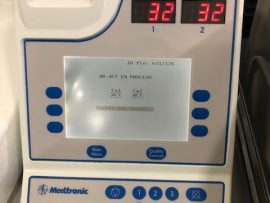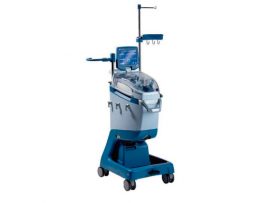Abstract Objectives Activated recombinant factor VII (rFVIIa) has been used to treat cardiac surgical bleeding in an off-label manner. Due to the high risk of mortality with ongoing hemorrhage, assessing..
Read MoreAbstract Introduction Viscoelastic point-of-care diagnostics are crucial in cardiac surgery. In the FIBTEM assay of rotational thromboelastometry (ROTEM), guidelines suggest target maximum clot firmness values to reduce perioperative bleeding. The..
Read MoreAbstract Introduction In the postoperative intensive care setting after cardiac surgery with cardiopulmonary bypass (CPB), particularly in patients requiring continued anticoagulation for prosthetic devices such as mechanical valves or extracorporeal..
Read MoreAbstract In clinical extracorporeal membrane oxygenation (ECMO), prolonged blood residence time in oxygenators can lead to thrombus formation and complications. Heparin-based bioactive coatings are commonly used for anticoagulation, but prolonged..
Read MoreAbstract Transfusion management during cardiac surgery is commonly guided by algorithms using viscoelastic tests such as Rotational Thromboelastometry (ROTEM). Recently, the ROTEM Sigma, a new device developed as a fully..
Read MoreAbstract Objective Overdiagnosis occurs when abnormalities meeting diagnostic criteria would remain asymptomatic if undiagnosed. Cases initially identified through digital diagnostic tools but later recognised as overdiagnosis are referred to as..
Read MoreCovalent Organic Framework-Based Porous Anticoagulant Materials for Extracorporeal Blood Circulation
Abstract Preventing coagulation during extracorporeal blood circulation is critical for clinical treatments. Developing anticoagulant materials for key components can reduce reliance on systemic anticoagulants and improve safety. However, such materials..
Read MoreAbstract Amniotic fluid embolism (AFE) is a critical obstetric complication characterized by the entry of amniotic fluid and its components into maternal circulation during parturition, leading to acute cardiopulmonary failure,..
Read MoreAbstract Background: Compared to heparin, there is limited evidence of the benefits of bivalirudin in the patients with extracorporeal membrane oxygenation (ECMO). Methods: We searched for studies comparing bivalirudin anticoagulation..
Read MoreAbstract Von Willebrand factor (vWF) orchestrates hemostasis through platelet activation, factor VIII stabilization, and inflammatory modulation, with emerging evidence highlighting its shear-dependent conformational dynamics as a critical regulator of thrombus..
Read MoreAbstract The advancement of has introduced a new dimension to managing patients who do not respond to conventional treatment of severe . (ECMO) is a specialized temporary life support that serves as a..
Read MoreAbstract Objectives To determine whether heparin resistance (HR) occurring during (CPB) is associated with (antithrombin III) activity. Design Retrospective review of data collected prospectively in a single center. Setting A tertiary referral..
Read MoreAbstract Extracorporeal membrane oxygenation (ECMO) is a mechanical circulatory and respiratory support system that facilitates gas exchange and hemodynamic stabilization through an external circuit. ECMO has been increasingly utilized for..
Read MoreAbstract Background Heparin-induced thrombocytopenia (HIT) is an immune-mediated platelet disorder caused by antibodies that target complexes of platelet factor 4 (PF4) and heparin. HIT has been characterized as a polyclonal..
Read MoreAbstract Introduction Bleeding and thrombosis are major causes of morbidity and mortality in pediatric extracorporeal membrane oxygenation (ECMO), yet their evolving, time-dependent risks remain poorly defined. This study evaluated clinical..
Read MoreAbstract Objectives Residual heparinization is a preventable cause of coagulopathy following cardiac surgery. The aim of this work was to assess the proportion of patients with residual heparinization following cardiac..
Read MoreAbstract Objectives The present study was designed to investigate the equivalence of two target activated clotting time (ACT) values with regard to packed red blood cell (PRBC) transfusion in patients..
Read MoreAbstract Rationale: Life-threatening airway obstructions caused by tumors demand prompt and effective intervention. Traditional surgical methods are often complicated by bleeding risks, especially with the use of anticoagulation during extracorporeal..
Read MoreAbstract Objective To test the feasibility and effectiveness of implementing the HemoClear microfiltration cell-salvage system for cesarean sections in South Africa. Methods We conducted a prospective experimental single-arm feasibility study..
Read MoreAbstract Objectives To ascertain the dosage of bivalirudin in neonates and infants undergoing arterial switch operation on integrated extracorporeal membrane oxygenation–cardiopulmonary bypass (CPB) circuit. Design Pilot study. Setting A tertiary..
Read More1. Introduction Sickle Cell Disease (SCD) is a chronic, inherited blood disorder resulting from a single point mutation in the β-globin gene. This mutation leads to the production of hemoglobin..
Read MoreAbstract Objectives Antithrombin (AT) deficiency is considered the primary cause of heparin resistance (HR); however, some patients with HR have normal AT activity (AT-independent HR). Supplementation with concentrated human AT..
Read MoreAbstract Solutions to reduce the need for systemic anticoagulation during extracorporeal life support would improve safety and utility. The study objective was to evaluate the safety and efficacy of a..
Read MoreAbstract Extracorporeal membrane oxygenation (ECMO) is a form of life support for critically ill patients with severe respiratory or cardiac failure. Interactions between patient blood and ECMO biomaterials increase the..
Read MoreAbstract Objective To review and compare the frequency of thrombus and adverse events in patients treated with heparin or bivalirudin systemic anticoagulation strategies supported on combined venoarterial extracorporeal membrane oxygenation..
Read MoreAbstract Background Veno‑venous extracorporeal membrane oxygenation (VV‑ECMO) is associated with a high transfusion burden. While trials have concluded that red blood cell (RBC) storage does not impact patient morbidity and..
Read MoreAbstract Background Evidence for the effectiveness of the Sonoclot analyzer in improving clinical outcomes in disseminated intravascular coagulation (DIC) is lacking. Objective To evaluate the effectiveness of an algorithm based..
Read MoreAbstract Aortic surgeries are associated with intraoperative blood loss, often requiring allogeneic blood transfusion. Therefore, blood must be viewed as a scarce resource that carries risks and benefits. Many preoperative..
Read MoreAbstract Rapid hemodynamic stabilization and restoration of pulmonary perfusion are the cornerstones of treatment for high-risk pulmonary embolism (PE). While all current guidelines recommend systemic thrombolysis (SYS) as the first-line..
Read MoreAbstract Objective To report differences between 2 anticoagulation protocols during venoarterial extracorporeal membrane oxygenation (VA-ECMO) intraoperative support and their effects on outcomes after lung transplantation. Methods We performed a retrospective..
Read More












